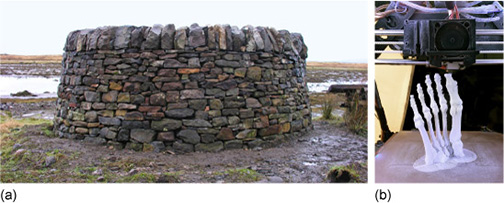
ROHINUR
Traditional methods of manufacturing typically involve either removal of material from a piece of stock material or the joining of several pieces of material together. Another option is casting, moulding or extruding, where the final geometry is made using a die or mould of some kind. In these methods the final geometry is only produced after a combination of processes.
Additive manufacturing, on the other hand, produces a component by the addition of material to create the final geometry in a single process.
The fundamental idea behind AM is not in any way new. Think about how bricks create a building or how dry stone walls are created (Figure 1a). The application of these ideas to manufacturing in an engineering sense came to fruition only at the turn of this century (Figure 1b).

Figure 1(a) shows a curved wall or small tower created from Jurassic limestone. Wall is built up fom a range of stones. Figure 1(b) shows foot bones protuding from the floor. The bones have been printed in plastic.